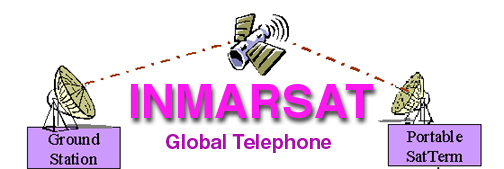 Use
of INMARSAT
Global Satellite Communications enables the Learning Technologies Project
to broadcast educational events and information from remote locations
and allows students to participate in live interaction with professionals.
This is possible through the connection of a laptop at a remote
Use
of INMARSAT
Global Satellite Communications enables the Learning Technologies Project
to broadcast educational events and information from remote locations
and allows students to participate in live interaction with professionals.
This is possible through the connection of a laptop at a remote
site to the NASA Glenn Research Center
network. Internet access is established through the use of a NERA Saturn
Bp IMARSAT B satellite terminal unit and through terrestrial ISDN lines
and routers.
The NASA Glenn team constructed this hybrid
data link. The configuration consists of the remote laptop, connected
through an ISDN router, to the INMARSAT satellite terminal unit.
Data signals transmitted from the INMARSAT unit are received by a ground
station. At the ground station, the data is transmitted over ISDN lines
to the NASA GRC ISDN network. The routing and internet service
is established at NASA Glenn.
Graphic
of INMARSAT Configuration
The INMARSAT demonstrates the NASA Learning
Technologies Project's contributions to the goal of using leading edge
technologies to deliver NASA mission content to classrooms across the
nation. NASA Glenn Research Center is also able to demonstrate its expertise
in wireless communications applications and the benefits of using this
technology within the educational community.
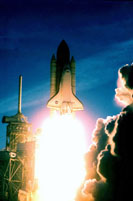 STS
- 96 Launch - May 27, 1999
STS
- 96 Launch - May 27, 1999
The INMARSAT was used to broadcast
the STS-96
launch. STS-96
was a logistics and resupply mission for the International Space Station.
It was the first flight to dock to the International Space Station and
an international crew of seven became the first visitors to the new
International Space Station since its launch and start of orbital assembly
last year. The Student Tracked Atmospheric Research Satellite for Heuristic
International Networking Equipment (STARSHINE)
satellite was also released during this mission. The STARSHINE satellite
is a 19-inch hollow sphere covered by over 800 polished aluminum mirrors.
International student volunteer observers will visually track this optically
reflective spacecraft during morning and evening twilight intervals
for several months, calculate its orbit from shared observations, and
derive atmospheric density from drag-induced changes in its orbit over
time.
Date May 27, 1999
5:30 am Eastern Daylight Time
RealMedia
(audio and video) archive
Marsokhod
Desert Field Test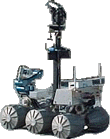
February 5, 1999
The Marsokhod Desert Field test was a Marsokhod
Mars rover mission simulation. This field
test involved a rover (see image on right) at a remote site, and a team
of NASA scientists who are operating the rover. Marsokhod is an analog
of rovers that will be sent to Mars as part of several missions over
the
next decade. To learn how rovers will
operate on Mars, scientists are studying
how Marsokhod operates on Earth in a Mars-like location such as the
desert. The
INMARSAT
was used to broadcast
the
rover testing live from the
middle of the desert.
RealMedia
(audio and video) archive
Arctic
Exploration On-Line - July 27
and July 30, 1998
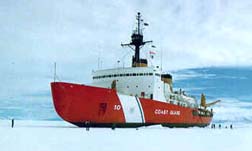 This
project allowed the LTC to broadcast live from the Alaska
coast onboard the Coast Guard cutter the Polar
Star. The Polar
Star is one of
the world's most powerful non-nuclear icebreakers and operate from their
homeport at Pier 36, Seattle, Washington. Polar Star's primary missions
are scientific support in the Arctic and Antarctic and ice escort of
shipping and logistics support for U.S. Government interests in both
polar regions.In addition to providing support to scientific stations,
Polar
Star is equipped to function as a major
scientific platform. It has laboratories, offices, and sleeping quarters
which can support 20 scientists and technicians in a variety of programs.
Polar Star, like all Coast Guard vessels, is also prepared to perform
search and rescue, law enforcement, and environmental response missions.
This
project allowed the LTC to broadcast live from the Alaska
coast onboard the Coast Guard cutter the Polar
Star. The Polar
Star is one of
the world's most powerful non-nuclear icebreakers and operate from their
homeport at Pier 36, Seattle, Washington. Polar Star's primary missions
are scientific support in the Arctic and Antarctic and ice escort of
shipping and logistics support for U.S. Government interests in both
polar regions.In addition to providing support to scientific stations,
Polar
Star is equipped to function as a major
scientific platform. It has laboratories, offices, and sleeping quarters
which can support 20 scientists and technicians in a variety of programs.
Polar Star, like all Coast Guard vessels, is also prepared to perform
search and rescue, law enforcement, and environmental response missions.
- July 27: An interview with the Captain
of the Polar Star.
- July 30: An interview with an engineer
onboard the Polar Star.
The
French Connection - May 13, 1998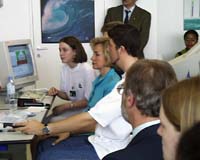
The NASA Glenn Research Center Learning
Technologies Projectand the Computer Services Division set up a mobile
Internet connection for an Internet demonstration involving French and
American schools. The NASA Learning Technologies Project Office at NASA
ARC conducted an Internet demonstration on May 13th which consisted
of video interaction over the Internet by a school in Washington DC
and a school in France. NASA Administrator Dan Goldin and First Lady
Hillary Clinton participated in the demonstration.
- Archive of Broadcast
in English
- Archive of Broadcast in French


 Use
of
Use
of  STS
- 96 Launch - May 27, 1999
STS
- 96 Launch - May 27, 1999
 This
project allowed the LTC to broadcast live from the Alaska
coast onboard the Coast Guard cutter the
This
project allowed the LTC to broadcast live from the Alaska
coast onboard the Coast Guard cutter the 